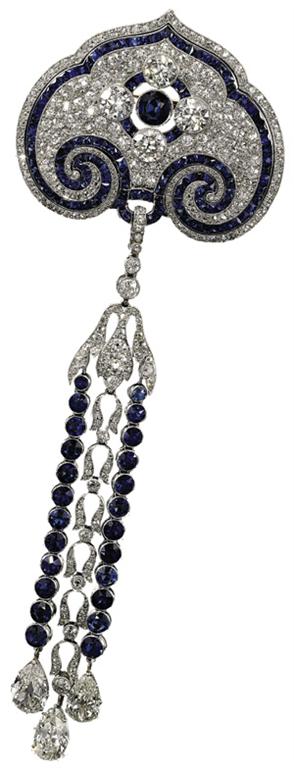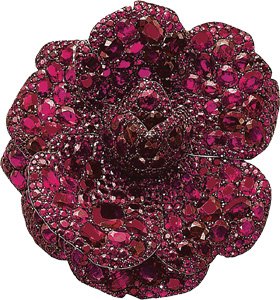Recession? Greek default? Euro-zone crisis? Not in Geneva.
The spectacular results achieved during the three days of jewelry auctions on
May 14, 15 and 16 might have been an indirect response to the economic distress
being felt in Europe and around the world. Whatever the reason, bidders
competed with enthusiasm and dollars. Buyers showed no fatigue in the face of a
combined total of 1,137 lots offered by Christie’s and Sotheby’s. When the dust
settled, the two houses racked up a staggering total of $222,025,570 for two
Magnificent Jewels auctions and two single-owner sales.
In spite of enormous interest from private clients, members
of the trade were active buyers throughout the Geneva sales, picking up many of
the top ten lots at both houses. In many instances, they were willing to pay
well over the estimates to secure top-quality, fresh-to-the-market goods.
SOTHEBY'S
Sotheby’s tallied up $111,836,526. The Suzanne Belperron
sale accounted for $3,459,307 of that total, triple its presale estimate, and
was 100 percent sold. The Magnificent and Noble Jewels portion of the sale
offered 585 lots and was sold 85 percent by lot and 95 percent by value. It
totaled $108,377,219, setting a new world record for the auction house for a
various-owner Magnificent Jewels sale. A private-owner sale contributed $18,732,203 to the Magnificent Jewels
total. Trade buyers picked up seven of the top ten lots in this 78-lot event.
During the two days of sales, Sotheby’s sold 24 lots for more than $1 million.

|
Sapphire and diamond brooch/pendant, circa 1910, was sold by Sotheby’s for $414,587.
|
The highlight of Sotheby’s Magnificent and Noble Jewels sale
was the historical Beau Sancy diamond, with a royal pedigreed provenance, which
sold for $9,699,618* (see box on page 140) to an anonymous buyer bidding over
the telephone, who won the stone in a round of bidding against four others.
Most of the jewels in the 60-lot sale of designer Suzanne
Belperron were her own designs — and all top ten sellers were her pieces —
while some were simply part of her personal jewelry box. Rock crystal and
diamond pieces took the top two spots, with a ring selling for $498,255 and a
brooch going for $324,483.
Lee Siegelson, a New York City dealer known for the finest
period gems and jewels, paid $1,094,382 for a pair of natural pearl and diamond
earrings, 12 times the presale low estimate. “The pearls in all of the sales
were very strong,” he noted. In all, Sotheby’s offered 60 lots of natural
pearls and the buyers swooped in to buy them at extraordinary prices. According
to David Bennett, chairman of Sotheby’s Jewelry in Europe and the Middle East,
“Natural pearls for most of my career were in the doldrums. It’s only for the
past five years that pearls have taken off.” The Murat Tiara, made by Chaumet
in 1920, featured an enormous button-shaped pearl and two slightly smaller
pearls. It was sold for $3,872,875 in a bidding battle that lasted 11 minutes.
CHRISTIE'S
Christie’s garnered $110,189,044. The Lily Safra sale made
up $37,924,551 of that total, nearly double the presale estimate, and was 100
percent sold. There were 345 lots in the Magnificent Jewels sale, which was
sold 84 percent by lot and 86 percent by value and made up $72,264,493 of the
overall total.

|
Ruby Camellia brooch by JAR was sold by Christie’s for $4,323,240.
|
The global reach of the sale and the variety of goods on
offer could be seen in the top two lots, an antique Indian sarpech and a pair
of ear pendants by Harry Winston. The sarpech, a mideighteenth-century turban
ornament set with numerous emeralds, was sold for $4,718,060, nearly five times
the high estimate. The Winston diamond earrings, set with two pear-shaped D,
VVS2 diamonds weighing 16.21 carats and 15.67 carats, were sold for $4,065,100.
The third-top lot for Christie’s was a 47.15-carat octagonal Burmese sapphire
brooch that sold for $3,649,580, or $77,500 per carat, a record per-carat price
for a Burmese sapphire.
Proceeds from the 69-lot jewelry collection of art patron
and philanthropist Lily Safra were to benefit a number of charities, each to
receive $1 million. According to Jean-Marc Lunel, head of jewelry for
Christie’s Geneva, as the hammer came down on the last lot, Mrs. Safra entered
the room to announce that the enormous success of the sale allowed her to
include 12 additional charities on the list of beneficiaries who will share in
the money raised.
The Safra sale set a world record for a ruby sold at
auction. The Hope Ruby, a cushion-shaped Burmese stone weighing 32.08 carats,
set in a ring by Chaumet, sold to Dubai-based diamond dealer Amer Radwan for
$6,742,440, against a presale estimate of $3 million to $5 million. The Safra
collection also included 18 lots by JAR, the idiosyncratic American-in-Paris
jewelry designer. It was the largest collection of JAR pieces ever offered at
auction from a single collection. The exquisite JAR Camellia ruby brooch on the
catalog cover, estimated at $1.2 million to $1.5 million, brought out fierce
bidding by JAR’s followers, finally selling for $4,323,240, a record for this
jeweler at auction.
ONLINE BUYING
The sales reflect a sea change in the way auctions are
conducted. In the not-so-distant past, by the time auction day rolled around,
the experts and managers at the auction houses had an idea of a sale’s success
before the first lot was offered. They had the “book,” the all-encompassing
volume indicating every written bid submitted prior to the auction. They had
gauged the interest expressed by clients, either in person or on the phone.
Clients could phone in bids from virtually anywhere in the world, from any time
zone.
And then came the internet. Buyers could place bids online,
while the auction was proceeding. At about the same time, anyone could browse
the catalog online, seeing jewelry in full color. They could view the details
of a lot by enlarging the image; they could read the detailed description as
well as any accompanying certificates and they could print out copies of those
items that interested them. This proved to be the change that opened up the
auction to everyone in the world with a high-speed connection.
Bennett says the success of the sales can be traced directly
to the internet. “I think more people are aware; the internet bids are
increasing. The number of people who looked at the catalog online was phenomenal.
That is the one big development; it has really taken us up to another level.
It’s not possible to send out 100,000 catalogs. This means people who are
traveling can access a catalog from a hotel. This helped our auction
enormously.”
There has been a huge increase in the value of individual
lots from five to ten years ago. “We are touring the goods all over the world
and the e-catalogs can be viewed at home. Also, clients have a lot of advice
from us, right on the spot. We can communicate with clients we have never met,
very quickly and in a very friendly way,” concludes Lunel. “That has changed
our business.”
- All prices include buyer’s premium.
BEAU SANCY
For 400 years, the exquisite 34.98-carat Beau Sancy diamond
passed through the royal families of Europe. The modified pear double rose cut
most likely came from Golconda in India. It first graced the crown of Marie de
Medici at her 1610 coronation as Queen consort. Her husband, Henry IV, was
assassinated the next day. Later in her life, needing money, she pawned the
stone. It was subsequently purchased by Prince Frederick Henry of Orange, Count
of Nassau, who gave the diamond to his daughter-in-law, Mary Stuart, daughter
of Charles I of England and granddaughter of Marie de Medici. In 1659, Mary
Stuart, after the death of her husband, pawned the Beau Sancy to finance the
restoration of her brother Charles II to power. Following a few years of
dispute over the diamond’s ownership, it was presented at the marriage of Mary
Stuart’s son William to his bride. The couple was childless at their death so
the Beau Sancy passed by inheritance to Prince Frederick III, who was crowned
Frederick I, King of Prussia, in 1701. As the most important stone in the
Prussian crown jewels, it symbolized the aspirations of the court and was
considered a talisman of the House of Prussia. It was worn in the crown until
1822, when it was reset as a pendant. The Beau Sancy remained with the House of
Prussia throughout the turbulence of the twentieth century.
When the Beau Sancy arrived at Sotheby’s for sale by the
Royal House of Prussia, it was the first time it had ever been out of royal
hands. The K color, SI1 clarity stone was estimated to bring $2 million to $4
million. At auction, its unique cut and remarkable provenance enticed an
anonymous buyer to spend $9,699,618. David Bennett, chairman of Sotheby’s
Jewelry in Europe and the Middle East, noted, “When we showed the stone to
cutters, they were astonished that the cutters of the time, the sixteenth
century, could achieve that result with the tools they had.”
Article from the Rapaport Magazine - June 2012. To subscribe click here.